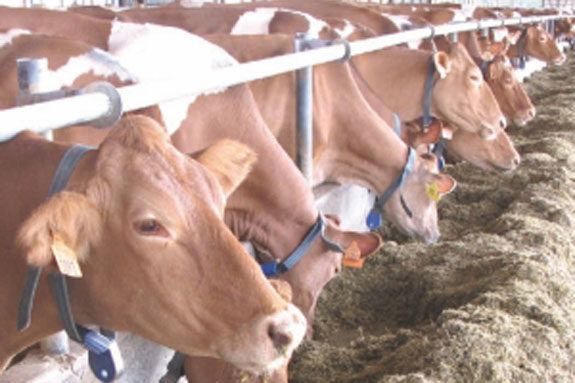"Maturity is important, if your grass hay becomes too mature, you know that the plant becomes less digestible and the available nutrient
levels drop. Corn is no different, you need to pay attention to management in the field if you are going to produce a quality feed.”
Waldron spoke about corn silage at the 2011 Missouri Dairy Profit Seminar series, sponsored by the Missouri Dairy Association, University of Missouri Extension, and the UM Extension Commercial Agriculture Program.
The annual Dairy Profit series was held at five locations throughout the state and featured dairy experts and industry representatives.
“Although corn is a grass, because the seed portion of the plant makes up such a large percentage of the plant, you need to think about managing two components: stover and grain.” Waldron explained that stover encompasses the leaves, stalks and cobs – approximately 55 to 60 percent of the plant.
Although the plant’s yield increases as it matures, stover becomes less nutritious as the plant matures.
Grain comprises about 40 to 45 percent of the plant. Most of the kernel is made up of starch, and this starch composes about 25-30 percent of the whole plant dry matter.
Compared to the stover, kernels are very digestible because in general, starch is very digestible (~80-95 percent). One of the factors that has the greatest effect on starch digestibility is maturity at harvest.
Kernels become more calorie dense as the plant matures, but digestibility decreases as the kernel progresses from milk stage to black layer stage. Research from the University of Wisconsin also suggests that starch digestibility varies greatly by hybrid.
When selecting a seed hybrid for corn silage, Waldron strongly recommends using a hybrid that was developed by a reputable company specifically for silage.
“In selecting a silage hybrid, consider the hybrid’s NDF (neutral detergent fiber), starch and NDFD (NDF digestibility),” said Waldron. “Special genetic traits can help predict silage yield and affect milk production per ton of dry matter (DM).”
Once selected, success with the chosen hybrid depends on management. Waldron recommended soil sampling to determine fertility, adding soil nutrients, and adjusting soil pH if necessary.
“Don’t let weeds grow up. Use herbicides, or else competing weeds will decrease tonnage and decrease nutrient value of the feed,” Waldron cautioned.

Another aspect of management that is critically important is maturity at harvest. Corn silage digestibility decreases at the plant matures and there also needs to be enough moisture in the plant to allow a good fermentation in the silo.
“This is highly variable depending on environmental conditions and hybrid, but as a rule of thumb, whole plant moisture drops about 0.5% per day near harvest,” said Waldron.
To test whole plant DM, he recommended using a Koster tester, lab testing, or even a microwave oven, taking representative samples from all over the field.
Another method to estimate whole plant moisture is to monitor the kernel milk line as the plant matures. This estimate of starch accumulation in the kernel is correlated with whole plant maturity and dry matter content.
“However, I want to emphasize that the ideal of a ½ milk line, does not always coincide with correct whole-plant moisture,” Waldron cautioned. Milk line can be affected by hybrid, environmental conditions, and a number of other factors.
“Therefore, although it is an estimate of whole-plant moisture, it’s not a great one and you are always better off actually measuring whole plant dry matter using other methods such as the Koster, microwave, or lab,” said Waldron.
To determine the milk line, break an ear in half and run a ballpoint pen down the kernel on the “tip” side of the ear. Wherever the ball-point pen pushes into the side of the kernel, that is the milk line percentage.
For example, if the pen sinks in ¼ of the way down, it is ¼ milk line, ½ way down, it is ½ milk line, etc.
Waldron also offered advice on the four phases of silage: aerobic (containing oxygen), anaerobic (oxygen depleted), stable (storage), and feeding. “Lactic acid bacteria are very important in the anaerobic stage,” he said.
“Improper harvest or storage conditions result in a poor anaerobic fermentation and lack of acid to properly preserve the feed.” Poor fermentation can lead to spoiled feed, mold growth, poor nutrient availability, and health problems with your cows.
“There are a lot of details to manage when making good corn silage,” Waldron said, “You’ve got to stay on top of it from field to feed. You don’t want to do a great job in the field and then screw it up during storage. Also, you can do a great job of storage and feed-out, but that’s not going to correct problems that were created in the field.”
Seminar attendees also heard presentations from UM dairy veterinarian, Scott Poock; Alltech area sales manager, Keith Schwinke; Kelly Perfield, technical consultant, Elanco Animal Health; Lewis Anderson, national sales manager and calf management consultant, Calf-Tel by Hampel Corporation; and Dave Drennan, Missouri Dairy Association. FG
—Excerpts from University of Missouri Extension Commercial Agriculture Program website
PHOTOS
PHOTO 1: Cows eating TMR.
PHOTO 2: Corn silage chop length. Photos courtesy of University of Missouri Extension
Michelle Proctor
Senior Information Specialist
University of Missouri Extension










